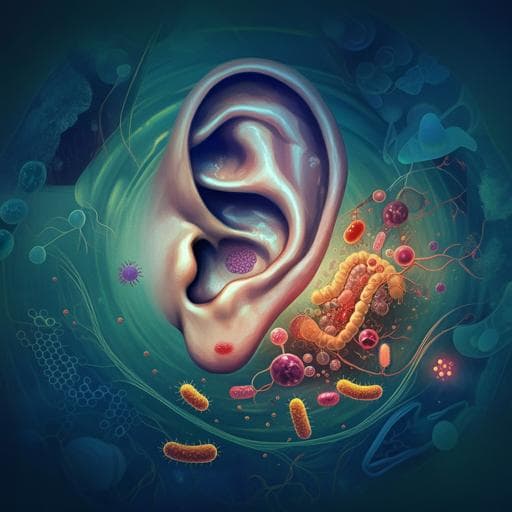
Veterinary Science
Dietary prebiotics promote intestinal *Prevotella* in association with a low-responding phenotype in a murine oxazolone-induced model of atopic dermatitis
A. Laigaard, L. Krych, et al.
This study, conducted by Ann Laigaard and colleagues, reveals how xylooligosaccharide (XOS) can significantly reduce dermatitis responses and enhance gut microbiota composition in a murine model. With better gut health linked to higher *Prevotella* spp. levels, this research opens doors for innovative microbiota-targeted therapies in allergy management.
~3 min • Beginner • English
Introduction
Atopic dermatitis is a chronic, intermittent, pruritic eczema typically beginning in infancy or early childhood and is common in Western countries. Approximately 80% of patients develop IgE-associated (extrinsic) dermatitis characterized by elevated serum IgE. While traditionally viewed as Th2-dominated (IL-4, IL-5, IL-10), recent findings indicate a mixed Th1/Th2 response with IFN-γ-producing CD8+ T cells. In mice, repeated topical hapten exposure (e.g., oxazolone) can shift from an acute type 1 response to a chronic mixed/type 2-like inflammation, mirroring human disease. Environmental factors, including the gut microbiota, are implicated in disease risk and modulation. Previous work showed strong correlations between gut microbiota composition and severity of oxazolone-induced dermatitis in BALB/c mice, and that high- and low-responding phenotypes are transferable to germ-free mice via microbiota, implicating causality. This study investigates whether dietary prebiotic xylooligosaccharide (XOS) can beneficially modulate the gut microbiota and attenuate oxazolone-induced dermatitis, with a focus on identifying microbial taxa associated with low-responding phenotypes.
Literature Review
Epidemiological and experimental data link early-life gut microbiota composition to atopy risk, with differences observed by geography, delivery mode, and antibiotic exposure. Prior animal studies reported that fructo-oligosaccharides (FOS) can reduce contact hypersensitivity (e.g., DNFB model in NC/Nga mice), with partial effects from Bifidobacterium supplementation alone, suggesting additional microbial pathways beyond bifidogenesis. Enterotype-dependent responses to oligosaccharides are documented, leading to distinct short-chain fatty acid profiles that may differentially affect host immunity. Prevotella spp. are fiber-utilizers in humans and can be expanded by high-complex carbohydrate diets; their immunological roles appear context-dependent: associated with Th17 and rheumatoid arthritis risk (e.g., P. copri) and with worsened colitis in some models, but also enriched in healthy lungs versus asthma/COPD and capable of reducing inflammatory cytokines in lung cell models. Lactobacillus reuteri has been associated with lower Th2 responses in early life in humans. These mixed findings motivate evaluating how prebiotics that alter Prevotella abundance influence Th2-driven skin inflammation.
Methodology
Animals and housing: Thirty-two 4-week-old female BALB/cJBomTac mice were obtained as Murine Pathogen Free and housed in a barrier facility under FELASA recommendations (22 ± 2 °C, 55% ± 10% RH, 15–20 air changes/h, 12 h light cycle). Mice were randomly assigned to two diet groups (n=16 each; 4 cages/group): control Altromin 1430 diet or the same diet supplemented with 47.5 g/kg XOS (DP 2–6). Diets provided ad libitum; NFE per label: 427.5 g/kg (XOS diet) vs 475 g/kg (control). Untreated tap water ad libitum; enrichment and bedding provided. Food and water consumption per cage measured weekly.
Experimental design and dermatitis induction: After 33 days on diet, mice were sensitized on Day -7 with 0.8% oxazolone in 4:1 acetone:olive oil, 20 µL applied to both sides of the right pinna. Challenges used 0.4% oxazolone on Days 0, 3, 5, 7, 10, 12, 14, 16, 18, and 20 (10 total applications). Treatment order alternated between groups across days. Euthanasia and sampling occurred on Days 21 and 23.
Clinical assessment: Ear thickness measured on Day -7 and immediately pre-euthanasia (duplicate measurements by the same operator) using a low-force caliper. Post mortem, two blinded scorers assessed clinical skin inflammation on four parameters: redness, thickening, excoriation/erosion, incrustation; each scored 0–3 (none, mild, moderate, severe), summed to a total score 0–12. The average of two scorers was used per mouse.
Histology: From 3 mm ear biopsies fixed in 4% formaldehyde and paraffin-embedded, 2 µm sections were stained with H&E and toluidine blue. Blinded scoring at 4x, 10x, 40x for (i) epidermal spongiosis, (ii) dermal hyperplasia, (iii) mast cell infiltration, (iv) fibroplasia; each 0–3, total 0–12. Mast cells counted in two 40x HPFs (one each side of cartilage); mean count converted to 0–3 score (0 ≤1; 1 = 1–5; 2 = 6–10; 3 ≥10).
Serum IgE: Blood collected from anesthetized mice pre-decapitation; IgE quantified by ELISA (Bethyl), 1:20 dilution.
Ear tissue cytokines: From an 8 mm punch of the right ear, a central 3 mm sample was fixed for histology; the remaining ring was snap-frozen. Samples were homogenized in 300 µL MSD lysis buffer and analyzed on the MSD V-PLEX Proinflammatory Panel 1 (mouse) for IFN-γ, IL-1β, IL-2, IL-4, IL-5, CXCL1, IL-10, IL-12p70, TNF-α.
Gene expression: RNA from ear biopsies was isolated (MagMAX-96), cDNA synthesized (High-Capacity kit), and qPCR performed for Foxp3, Tgfb, Il4, Tnf with Actb as reference; analysis on ΔCT values.
Flow cytometry: Draining right superficial parotid lymph nodes processed to single-cell suspensions; stained panels included (i) CD3, CD8a, CD19b, NKT markers and (ii) CD4, CD103, intracellular FoxP3; analyzed on BD Accuri C6 with standard gating.
Gut microbiota profiling: Feces collected from 10 mice per group at Day -7 (pre-challenge) and at euthanasia. 16S rRNA gene amplicon sequencing (Illumina MiSeq V2 kit), targeting V3 region with Nextera-compatible primers (NXt_388_F and NXt_518_R). Reads (paired-end) truncated to 150 bp, merged, quality-filtered (max expected error E=2.0; N≤4), chimeras removed; OTUs constructed de novo via UPARSE; taxonomy assigned against Greengenes 13.8. Average yield ~170,000 sequences/sample. Downstream analysis in QIIME 1.7/1.8.
Beta diversity and differential abundance: PCoA via Jackknifed Beta Diversity using 10 distance metrics and 10 subsampled OTU tables (rarefaction: 50,000 reads/sample; subsets at 85% of minimum sample reads). Group differences assessed by ANOSIM on weighted and unweighted UniFrac. Differential taxa assessed by ANCOM (species-level summarized non-normalized OTU table; abundance threshold 0.1%).
Statistics: Normality assessed by D’Agostino-Pearson or Shapiro–Wilk (n<5). Group comparisons by unpaired t-test with Welch’s correction or Mann–Whitney U (n<5). ANOVA tested cage effects within groups. For clinical and histopathology scores, mice were dichotomized relative to the control group 75th percentile threshold to define high (≥ threshold) vs low responders; proportions compared by chi-square. GraphPad Prism v6 used for analyses and plots.
Key Findings
- Oxazolone induced dermatitis in all mice with increased ear thickness from baseline to euthanasia: control 777 ± 14 µm to 1175 ± 100 µm; XOS 778 ± 14 µm to 1157 ± 78 µm (p < 0.0001 for increase). No significant difference in final ear thickness between diets.
- XOS reduced high-responding phenotype prevalence: clinical high responders (≥ 75th percentile, score ≥7.5) were 6/16 in control vs 1/16 in XOS (p < 0.05). Histopathology high responders (total score ≥10) were 9/15 in control vs 3/14 in XOS (p < 0.05).
- Average serum IgE, ear cytokines, and ear gene expression did not differ significantly between diet groups, but showed substantial inter-individual variability correlating with clinical phenotypes.
- Food NFE intake and body weight were similar between groups, suggesting effects were not due to energy intake differences.
- Microbiota: Unweighted UniFrac PCoA showed distinct clustering of XOS vs control both pre- and post-challenge (ANOSIM p < 0.001, R = 0.36); no separation in weighted UniFrac. Neither oxazolone treatment nor cage drove clustering.
- Differential taxa: XOS increased Prevotella spp. and decreased Lactobacillus reuteri relative abundance (ANCOM p < 0.05). No Bifidobacterium spp. detected in any mouse.
- In control mice, Prevotella abundance negatively correlated with disease severity and inflammatory markers: clinical score (r² = 0.443), serum IgE (r² = 0.671), IL-4 (r² = 0.817), TNF-α (r² = 0.796), IL-5 (r² = 0.864), IL-10 (r² = 0.837), IL-12p70 (r² = 0.765), IL-1β (r² = 0.799), IL-2 (r² = 0.801), CXCL1 (r² = 0.776); all p < 0.05. Additional negative correlations observed with Enterococcaceae and Odoribacter for some markers. No significant correlations in the XOS group.
- Together, XOS feeding was associated with fewer high responders and enrichment of Prevotella, which was strongly linked to a low-responding phenotype.
Discussion
The study asked whether dietary prebiotic XOS can modulate the gut microbiota to attenuate oxazolone-induced atopic dermatitis-like inflammation. The data demonstrate that XOS feeding significantly reduced the proportion of mice exhibiting high clinical and histopathological responses without altering average ear thickness, indicating a shift in responder phenotype distribution rather than uniform suppression. Microbiota analyses revealed that XOS consistently altered community composition (unweighted UniFrac) with notable enrichment of Prevotella spp. and reduction of Lactobacillus reuteri. Prevotella abundance correlated strongly and negatively with clinical severity, serum IgE, and a broad panel of local cytokines in control mice, linking this taxon to a low-responding phenotype. The lack of group-wide differences in IgE and cytokine means, despite fewer high responders with XOS, likely reflects inter-individual variability and dependence on baseline microbial profiles; the protective effect may manifest primarily in individuals with low endogenous Prevotella. These findings extend prior reports that prebiotics (e.g., FOS) can alleviate contact hypersensitivity and suggest that non-bifidogenic microbial responses—specifically Prevotella expansion—can similarly confer protection in Th2-skewed skin inflammation. Contextually, Prevotella exhibits pro- or anti-inflammatory effects depending on disease model and niche; here, data support a protective role in atopic dermatitis-like inflammation. The results underscore the importance of host–microbiota stratification in designing microbiota-directed interventions for atopic disease.
Conclusion
Dietary XOS reduced the proportion of high responders in a murine oxazolone-induced dermatitis model and reshaped the gut microbiota, notably increasing Prevotella spp. abundance. Prevotella levels correlated strongly with lower clinical severity, reduced serum IgE, and decreased local inflammatory cytokines, indicating an association with a low-responding phenotype. These findings suggest that prebiotic-driven enrichment of Prevotella can alleviate atopic dermatitis-like inflammation even in the absence of Bifidobacterium. Future work should: (i) test Prevotella’s causal role and mechanisms in allergic disease models; (ii) evaluate timing (e.g., maternal/early-life) and dose of prebiotics; (iii) stratify by gut enterotypes to predict responders; and (iv) optimize dermatitis induction protocols to detect subtle immunomodulatory effects.
Limitations
- Immunological readouts (group means for serum IgE, cytokines, ear gene expression, lymph node phenotyping) did not differ significantly between diets, possibly due to high inter-individual variability and phenotype heterogeneity.
- The dermatitis induction regimen may have been too severe/frequent, potentially masking subtle dietary effects.
- Effects appeared dependent on baseline microbiota; not all mice responded similarly, and benefits may be confined to animals with low initial Prevotella abundance.
- No Bifidobacterium spp. were present, limiting conclusions about classic bifidogenic prebiotic effects and comparability with other studies.
- Timing of intervention (post-weaning) may miss heightened windows of immunomodulation (e.g., gestation/early life).
- Sample sizes for some assays were modest (e.g., n=4 for qPCR; n=6–10 for correlations), which may limit statistical power and generalizability.
Related Publications
Explore these studies to deepen your understanding of the subject.







